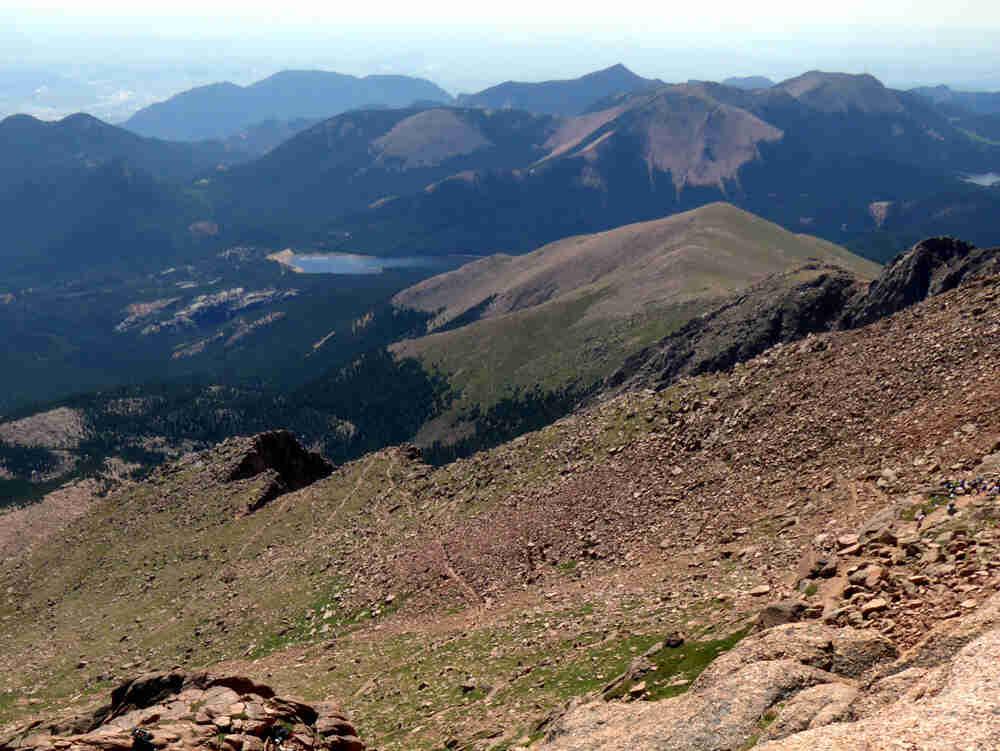Barr Trail
Full Article
Barr Trail is a 12.6-mile trail that climbs about 7,500 feet from Manitou Springs to the summit of Pikes Peak, with an average grade of 11 percent. Surveyed and constructed by Fred Barr in 1918–21, Barr Trail was the first trail to reach the summit via the mountain’s steep east slope. Today the iconic trail is the main pedestrian path up Pikes Peak, used by about 150,000 hikers and runners each year.
Early Routes up Pikes Peak
Native Americans made it to the summit of Pikes Peak many times, but the first recorded ascent of the mountain occurred in July 1820, when three members of Stephen Long’s expedition—the naturalist Edwin James and two soldiers, Joseph Verplank and Zachariah Wilson—reached the summit in two days from just south of what is now Colorado Springs. They took Fountain Creek to Ruxton Creek and followed it until they reached Pikes Peak’s southeast ridge around Sackett Mountain. From there they hiked on the ridge until they reached the summit.
Many early routes up Pikes Peak followed similarly circuitous paths that avoided the mountain’s steep east slopes by swinging south, gaining the southeast ridge, and then turning north along the ridge to the summit. In the early 1870s, for example, the engineer E. S. Nettleton developed a trail that followed Bear Creek southwest from Colorado Springs to Jones Park and Lake Moraine, then ascended the southeast ridge to the summit. A toll trail built in the early 1880s went up Ruxton Creek from Manitou Springs until it joined the existing trail on the southeast ridge. And when the Manitou and Pikes Peak Railway was built in 1889–91, it also followed Ruxton Creek to the southeast ridge.
Among the nineteenth-century trails up Pikes Peak, there was only one exception to the general preference for avoiding the mountain’s east slopes. The Fremont Trail, built in 1871, started at Iron Springs along Ruxton Creek. Instead of following the creek, however, it headed north toward Ute Pass, climbed the slopes of Mt. Manitou, and then traveled west to treeline, where it left climbers to pick their own way among the rocks to reach the summit. It was shorter than the trails that went up the southeast ridge but considerably steeper.
Building Barr Trail
By the 1910s, several of the early trails to the top of Pikes Peak had been abandoned, victims of the success of the Manitou and Pikes Peak Railway and the Pikes Peak Highway. Meanwhile, a local man named Fred Barr had secured a burro concession at the top of the Manitou Incline, which had started to take tourists up the side of Rocky Mountain and Mt. Manitou in 1908. Barr’s Mt. Manitou and Pikes Peak Burro Livery took tourists on rides around the summits of the small mountains near the top of the Incline.
Sometime in the mid-1910s, Barr started to plan a new trail to take tourists all the way up Pikes Peak’s east slopes to the summit. Work on what is now Barr Trail began in 1917, when the US Forest Service paid Barr and a ten-man crew to build a trail from Manitou Springs to No Name Creek. Today, this is the lower three miles of Barr Trail. Then, in 1918, Barr surveyed a trail from the top of the Incline to Pikes Peak. Intersecting the Forest Service trail at No Name Creek and probably incorporating some parts of the old Fremont Trail in his plan, Barr finished his survey at the summit on Christmas Eve. It took Barr and his trail-building crew more than two years to finish the trail, which opened to the summit in 1921.
Barr used his trail to lead burro trips from the top of the Incline to the summit of Pikes Peak. In 1922, with a concession from the US Forest Service, he established a tent camp along the trail at an elevation of 10,200 feet, where members of his trips could spend the night before waking early to reach the summit in time for sunrise. He gradually expanded and upgraded the camp, known as Barr Camp, building the main cabin in 1924 and two more in 1936. The area also had a barn for Barr’s burros.
Barr Trail Today
Since Barr’s death in 1940, the Forest Service and nonprofits such as Friends of the Peak have helped maintain Barr Trail and Barr Camp. The US Forest Service rebuilt the trail in 1948, following Barr’s route. In 1964 the Forest Service added a small A-Frame shelter near the trail at treeline, on the site of a cabin that Barr built in the summer of 1930.
Burros continued to travel up and down Pikes Peak until about 1959. After that, Barr Camp was vacant and suffered from vandalism for several years. In 1964 the Mennonite Church took over the camp’s lease, restored the buildings and grounds, and staffed the camp during the summer. The camp continued to suffer from vandalism when it was not staffed, however, and the Mennonite Church decided it could no longer maintain the area. In the early 1970s one of the cabins burned, and at some point the burro barn was also destroyed. The Forest Service was prepared to tear down the remaining two cabins, but a group of local hikers saved the camp by stationing someone there year-round starting in 1979. Still staffed by year-round, live-in caretakers, Barr Camp now hosts about 25,000 visitors per year and 2,500 overnight guests.
The Forest Service estimates that 150,000 people use Barr Trail each year, including hundreds of runners who participate in the Pikes Peak Marathon, which has taken place annually on Barr Trail since 1956.













